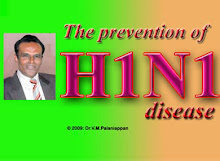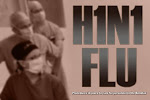Saturday, September 12, 2009
Friday, September 11, 2009
3, 205 deaths
(AFP) – 10 hours ago
GENEVA — The World Health Organisation said Friday that at least 3,205 people have died from swine flu since the new A(H1N1) virus was uncovered in April.
Most of the deaths occured in the Americas region, where 2,467 fatalities have been reported to the UN health agency.
The Asia-Pacific region recorded 527 deaths, followed by Europe where at least 125 people have succumbed to the infection.
The death toll in the Middle East reached 51 while the number of deaths in Africa climbed to 35, said the WHO in an update posted on its website.
The figure represents a jump of more than a 1,000 on a fortnight ago when the WHO said the overall toll stood at 2,185.
The WHO reiterated that the new flu virus is now the most prevalent form of influenza, having swiftly overtaken other flu viruses.
According to the WHO's flu database, 76 percent of flu detections reported during August 23 to 29 have been found to be of the pandemic strain.
The UN health agency also noted that flu activity appeared to be increasing in some parts of the northern hemisphere, which is about to enter the flu-prone winter season.
Parts of eastern Europe and south-east United States are reporting increases in infections.
In tropical South America and Asia, the caseload is also increasing. Countries such as Bolivia, Ecuador, Venezuela, India, Bangladesh and Cambodia are all reporting more flu cases, said the WHO.
Meanwhile, in Central America, the Caribbeans and the temperate regions of the southern hemisphere, the number of flu infections appear to be declining, it added.
Copyright © 2009 AFP. All rights reserved. More »
Related articles
- Flu policy decided by school districts, Alberta says
CBC.ca - 24 minutes ago - WHO: School closure can slow down spread of A/H1N1 virus
Xinhua - 1 hour ago - County has first flu death
Arkansas City Traveler - 5 hours ago - More coverage (5278) »
SOURCE
Tuesday, September 8, 2009
FLU in Singapore
Update on Influenza A (H1N1-2009) | |||
|
SOURCE
Tuesday, September 1, 2009
Forget H1N1 here's H5N1!
TNN 1 September 2009, 06:26pm IST| Bookmark/Share | Save | Comment | Text Size: | | |
H5N1 (Getty Images) |
The symptoms for swine flu and meningitis are largely the same – ranging from fevers, body aches, fevers and cold hands and feet. As the vacation period across the world comes to an end and people return from holidaying in far flung places, holiday makers are thought to be potentially contagious and capable of spreading the disease, making doctors brace for a second global outbreak.
This year in April, 2009, a severe meningitis outbreak hit Tripura and Meghalaya, with the government undertaking a drive to vaccinate the entire population with the World Health Organisation chipping in with 3.5 lakh vaccines. The fatal bacterial infection had sprung up in Tripura since January 2009 which recorded 126 confirmed meningitis cases and 33 deaths by April. The last major meningitis outbreak to strike India was in 2005, with over 80 people dying in the capital alone.
Meningitis is usually caused by either bacteria or a virus. Viral meningitis is more common than bacterial but is rarely life-threatening. Meningitis caused by bacteria tends to be more serious. Broadly, there are two types of bacterial disease: meningococcal and pneumococcal. Vaccines exist for both. Most cases of meningococcal meningitis can be treated with antibiotics, but it is important to catch the disease early.
Meningitis can kill in under four hours and parents should be watchful for the disease, Steve Dayman, chief executive of the charity Meningitis UK, told a UK-based newspaper. The disease, which affects children and teenagers the most, can be fatal if not immediately diagnosed. Typical symptoms of meningitis include a headache, stiff neck and a dislike of bright light. Other symptoms are difficulty supporting own weight, fever, vomiting and diarrhoea, confusion and drowsiness
SOURCE







